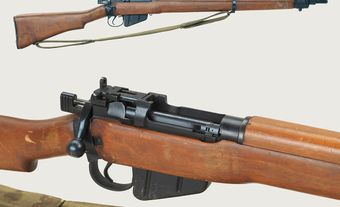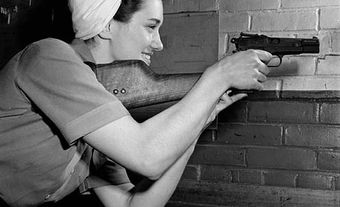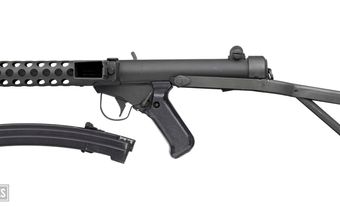The FN C1 7.62-mm self-loading rifle is the Canadian version of the FN FAL ― a gas-operated, magazine-fed weapon produced by Belgian armaments manufacturer Fabrique Nationale (FN) Herstal. It was the first semi-automatic rifle adopted by the Canadian Army and saw service from 1955 to 1985. Canada was also the first NATO country to use the rifle, which was later used by many militaries around the world. Replacing the Lee-Enfield, the C1 was itself later replaced by the C7 and C8.
Background
The concept for the rifle was based on lessons learned from the Second World War during which most combatants used bolt-action rifles. These could fire full-calibre rounds effective up to 1,000 metres and more. In reality, however, studies showed that in action most infantry fighting occurred somewhere between 300 to 400 metres or less. Additionally, most soldiers could not hit targets at the long ranges for which their weapons were designed.
These factors resulted in the idea of developing a smaller and less powerful cartridge, which would still be effective at standard combat distances. Smaller ammunition would also weigh less, allowing soldiers to carry more. Although Belgium was still recovering from German occupation at the time, Fabrique Nationale Herstal (FN) quickly began to design new weapons for the post-war era.
Between 1947 and 1953, Dieudonné Saive (who completed the design of the Browning 9-mm pistol) and Ernest Vervier worked on the design of FN’s Fusil Automatique Léger (FAL, or light automatic rifle in English) using several different calibres.
At the time, NATO members sought to standardize on a common rifle and calibre to facilitate logistics. Britain supported the idea of a less powerful calibre in 7 mm. They also pushed for their innovative and compact bullpup firearm design ― the E.M. 2 rifle. FN also supported the idea of a 7-mm cartridge but wanted the FAL to be adopted. On the other hand, the US wanted a more powerful 7,62-mm calibre cartridge akin to its Second World War-era.30-06 round. Faced with American opposition, NATO countries ended up standardizing on the US-designed 7.62x51 cartridge. (See also Canada and the United States.)
Meanwhile, Canada conducted experiments with the Belgian FN FAL. Canadian designers notably converted the metric design to imperial measurements. The Belgian design was also modified to Canadian specifications. Rather than only acquiring a few test models, Canada quickly ordered 2,000 rifles to conduct significant troop trials. In 1954, the rifle was adopted as the FN C1. The British and Australians also selected the FN FAL, based partly on successful Canadian experiments with the rifle.
Specifications
Unlike some versions of the FAL, which could fire on fully automatic, the FN C1 only had a semi-automatic fire mode. The FN C1 weighs 4.22 kg empty and is around 1.14 m long, with a barrel length of 53.4 cm. Chambered for 7.62x51 cartridges, the rifle uses a 20-round magazine. Unlike other FAL models, the magazine could be filled from the top using 5-round clips. A uniquely Canadian modification was the “Arctic trigger,” which allowed the standard trigger guard to be removed so the rifle could be fired while wearing heavy Arctic mittens. (See Cold Places in Canada.)
The C1 can be fitted with a bayonet and a grenade launcher. A blank-firing attachment (BFA) can be fitted to the end of the barrel to permit the firing blank ammunition on training exercises. The BFA serves two purposes: it prevents any unexpended blank material from escaping from the barrel (and possibly injuring someone) and forces gases back down the barrel to automatically recycle the next round to be fired.
Production in Canada
Canadian Arsenals Limited in Toronto produced 80,000 to 90,000 rifles under licence from FN. Of these, 72,470 were contracted to the Department of National Defence.
The FN C1 remained the standard rifle of the Canadian Armed Forces from its first production in 1955 until its replacement in 1985. By far the rifle’s biggest user was the Canadian Army.

Besides the armed forces, the Royal Canadian Mounted Police and the Ontario Provincial Police also used the C1 with slight modifications.
Variants
The C2 is a fully automatic light machine gun version of the C1. It replaced the Bren light machine gun as the standard infantry section support weapon. The C2 has a heavier barrel than the C1, a folding bipod and a 30-round magazine.
The C1 could be turned into a sniper rifle by the addition of a Sniper Scope C1, based on a scope made by German manufacturer Leitz. The company built a plant in Midland, Ontario, to manufacture the scopes. In 1959, Canada bought 305 scopes as part of the same order for the bulk of the rifles. The scope could be quickly attached to any rifle without the use of special tools.
The C1D was a fully automatic version of the C1 produced for naval boarding parties. The navy found the C2 too cumbersome for use aboard ships as they performed searches of suspect vessels. (See Royal Canadian Navy.)
Did you know?
Besides Canada, some 90 other countries used the FN FAL and it was manufactured in more than a dozen of them. Users include Australia, Austria, Belgium, Brazil, Britain, India, Israel, Jamaica, Malaysia, New Zealand, Rhodesia, Singapore, South Africa, Turkey and West Germany.
Replacement
The C1 and C2 were replaced in 1985. The C1 was replaced by two rifles, both of which fire 5.56-mm ammunition on either single or automatic. The C7 rifle is the personal weapon used by most service personnel. The C8 carbine automatic rifle is a shortened version of the C7, used when a more compact weapon is required by some personnel. This includes vehicle drivers, artillery crews, airborne troops and special operations personnel. The C2 was replaced by the C9 light machine gun, which also fires 5.56-mm ammunition, normally in a disintegrating belt of 200 rounds. It can also fire a 30-round magazine in emergencies.

 Share on Facebook
Share on Facebook Share on X
Share on X Share by Email
Share by Email Share on Google Classroom
Share on Google Classroom





